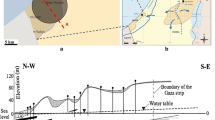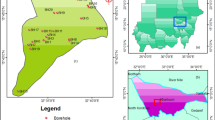Abstract
Nitrate concentration in groundwater is influenced by complex and interrelated variables, leading to great difficulty during the modeling process. The objectives of this study are (1) to evaluate the performance of two artificial intelligence (AI) techniques, namely artificial neural networks and support vector machine, in modeling groundwater nitrate concentration using scant input data, as well as (2) to assess the effect of data clustering as a pre-modeling technique on the developed models' performance. The AI models were developed using data from 22 municipal wells of the Gaza coastal aquifer in Palestine from 2000 to 2010. Results indicated high simulation performance, with the correlation coefficient and the mean average percentage error of the best model reaching 0.996 and 7 %, respectively. The variables that strongly influenced groundwater nitrate concentration were previous nitrate concentration, groundwater recharge, and on-ground nitrogen load of each land use land cover category in the well's vicinity. The results also demonstrated the merit of performing clustering of input data prior to the application of AI models. With their high performance and simplicity, the developed AI models can be effectively utilized to assess the effects of future management scenarios on groundwater nitrate concentration, leading to more reasonable groundwater resources management and decision-making





Similar content being viewed by others
References
Al-Mahallawi, K., Mania, J., Hani, A., & Shahrour, I. (2012). Using of neural networks for the prediction of nitrate groundwater contamination in rural and agricultural areas. Environmental Earth Sciences, 65(3), 917–928.
Almasri, M. N., & Ghabayen, S. M. S. (2008). Analysis of nitrate contamination of Gaza coastal aquifer, Palestine. Journal of Hydrologic Engineering, 13, 132.
Almasri, M. N., & Kaluarachchi, J. J. (2005a). Modular neural networks to predict the nitrate distribution in ground water using the on-ground nitrogen loading and recharge data. Environmental Modelling & Software, 20(7), 851–871.
Almasri, M. N., & Kaluarachchi, J. J. (2005b). Multi-criteria decision analysis for the optimal management of nitrate contamination of aquifers. Journal of Environmental Management, 74(4), 365–381.
ANERA (2012). Water in the West Bank and Gaza. on the ground in the Middle East (Vol. 2). Washington: American Near East Refugee Aid (ANERA).
Baalousha, H. (2006). Desalination status in the Gaza Strip and its environmental impact. Desalination, 196(1–3), 1–12.
Baalousha, H. (2008). Analysis of nitrate occurrence and distribution in groundwater in the Gaza Strip using major ion chemistry. Global NEST J, 10, 337–349.
Behzad, M., Asghari, K., & Coppola, E. A., Jr. (2010). Comparative study of SVMs and ANNs in aquifer water level prediction. Journal of Computing in Civil Engineering, 24, 408.
Bekesi, G., McGuire, M., & Moiler, D. (2009). Groundwater allocation using a groundwater level response management method—Gnangara groundwater system, Western Australia. Water Resources Management, 23(9), 1665–1683.
Cissé, I. A., & Mao, X. (2008). Nitrate: Health effect in drinking water and management for water quality. Environmental Research, 2, 311–316.
CMWU. (2010). Water status in the Gaza Strip and future plans. Gaza, Palestine: Coastal Municipalities Water Utility.
Coppola, E. A., Jr., Rana, A. J., Poulton, M. M., Szidarovszky, F., & Uhl, V. W. (2005). A neural network model for predicting aquifer water level elevations. Ground Water, 43(2), 231–241.
Dixon, B., (2009). A case study using support vector machines, neural networks and logistic regression in a GIS to identify wells contaminated with nitrate-N. Hydrogeology Journal, 17(6), 1507–1520.
Fiedler, F. R. (2003). Simple, practical method for determining station weights using Thiessen polygons and isohyetal maps. Journal of Hydrologic Engineering, 8(4), 219–221.
Goovaerts, P. (2000). Geostatistical approaches for incorporating elevation into the spatial interpolation of rainfall. Journal of Hydrology, 228(1), 113–129.
Güler, C., Thyne, G. D., McCray, J. E., & Turner, K. A. (2002). Evaluation of graphical and multivariate statistical methods for classification of water chemistry data. Hydrogeology Journal, 10(4), 455–474.
Hajhamad, L., & Almasri, M. N. (2009). Assessment of nitrate contamination of groundwater using lumped-parameter models. Environmental Modelling & Software, 24(9), 1073–1087.
Hamdan, S. M., Troeger, U., & Nassar, A. (2007). Stormwater availability in the Gaza Strip, Palestine. International Journal of Environment and Health, 1(4), 580–594.
Javadi, A., & Al-Najjar, M. (2007). Finite element modeling of contaminant transport in soils including the effect of chemical reactions. Journal of Hazardous Materials, 143(3), 690–701.
Kundu, M. C., & Mandal, B. (2009). Agricultural activities influence nitrate and fluoride contamination in drinking groundwater of an intensively cultivated district in India. Water, Air, and Soil Pollution, 198(1), 243–252.
May, D. B., & Sivakumar, M. (2009). Prediction of urban stormwater quality using artificial neural networks. Environmental Modelling & Software, 24(2), 296–302.
Metcalf & Eddy (2000). Coastal Aquifer Management Plan (CAMP). Final model report (task 7). . USAID.
Nourani, V., Mogaddam, A. A., & Nadiri, A. O. (2008). An ANN–based model for spatiotemporal groundwater level forecasting. Hydrological Processes, 22(26), 5054–5066.
Obeidat, M. M., Awawdeh, M., & Abu Al–Rub, F. (2012). Multivariate statistical analysis and environmental isotopes of Amman/Wadi Sir (B2/A7) groundwater, Yarmouk River Basin, Jordan. Hydrological Processes
PCBS (2012). Statistical Yearbook of Palestine (Vol. 12). Ramalla, Palestine: Palestinian Central Bureau of Statistics 2011.
Shomar, B. (2011). Groundwater contaminations and health perspectives in developing world case study: Gaza Strip. Environmental Geochemistry and Health, 33(2), 189–202.
Shomar, B., Osenbruck, K., & Yahya, A. (2008). Elevated nitrate levels in the groundwater of the Gaza Strip: distribution and sources. Science of the Total Environment, 398(1–3), 164–174.
Sugimoto, Y., Toyomitsu, Y., Muto, I., & Hirata, M. (2009). Factors associated with well-to-well variation in nitrate concentration of groundwater in a nitrate-polluted district in Miyakonojo Basin, Southern Kyushu, Japan. Water, Air, and Soil Pollution, 199(1), 23–32.
Trichakis, I. C., Nikolos, I. K., & Karatzas, G. (2011). Artificial neural network (ANN) based modeling for karstic groundwater level simulation. Water Resources Management, 25(4), 1143–1152.
UNEP. (2003). Desk study on the environment in the occupied Palestinian Territories. Geneva: United Nations Environment Programme.
UNEP. (2009). Environmental Assessment of the Gaza Strip following the escalation of hostilities in December 2008–January 2009. Nairobi, KENYA: United Nations Environment Programme.
WHO (2008). Guidelines for drinking-water quality, Third edition, Volume 1. World Health Organization, ISBN 9789241547611, Geneva.
Yakirevich, A., Melloul, A., Sorek, S., Shaath, S., & Borisov, V. (1998). Simulation of seawater intrusion into the Khan Yunis area of the Gaza Strip coastal aquifer. Hydrogeology Journal, 6(4), 549–559.
Yesilnacar, M. I., Sahinkaya, E., Naz, M., & Ozkaya, B. (2008). Neural network prediction of nitrate in groundwater of Harran Plain, Turkey. Environmental Geology, 56(1), 19–25.
Yoon, H., Jun, S. C., Hyun, Y., Bae, G. O., & Lee, K. K. (2010). A comparative study of artificial neural networks and support vector machines for predicting groundwater levels in a coastal aquifer. Journal of Hydrology, 396(1), 128–138.
Author information
Authors and Affiliations
Corresponding author
Rights and permissions
About this article
Cite this article
Alagha, J.S., Said, M.A.M. & Mogheir, Y. Modeling of nitrate concentration in groundwater using artificial intelligence approach—a case study of Gaza coastal aquifer. Environ Monit Assess 186, 35–45 (2014). https://doi.org/10.1007/s10661-013-3353-6
Received:
Accepted:
Published:
Issue Date:
DOI: https://doi.org/10.1007/s10661-013-3353-6




